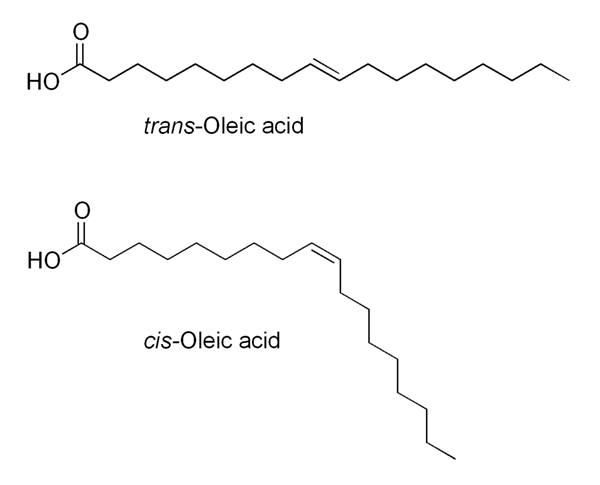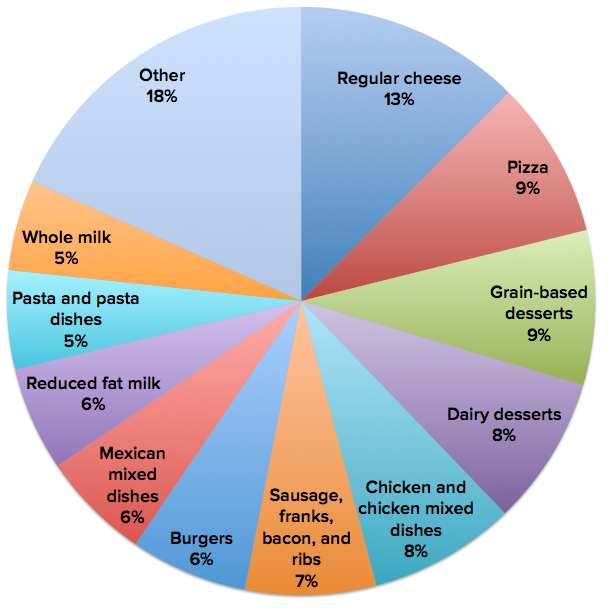At PN, we talk a lot about “good fats”, such as omega-3 fatty acids from sources like fish and walnuts. But if there are “good fats”, then by definition there must be “bad fats”.
The good news is that because most bad fats are created from industrial food processing, it’s difficult to get excessive amounts of bad fat from whole, unprocessed foods.
What are bad fats?
But to understand how a fat becomes “bad,” let’s talk first about fatty acid structure. I know, this borders on really “sciencey” but bear with us here…
Fatty acids are long chains of hydrocarbons. The molecules look sort of like caterpillars. Where a carbon-carbon double bond exists, there’s an opportunity for either a “cis” or “trans” configuration.
Now, virtually all naturally occurring unsaturated long-chain fatty acids have the cis configuration, which looks kinda like a caterpillar with a kink in it. Cis is good.

Trans fats
During processing, trans fatty acids can be created as a by-product of fatty acid saturation. This straightens out the caterpillar. Trans is bad.
Basically, trans fats are created by taking an unsaturated fat (soft or liquid at room temperature) and bubbling hydrogen ions through it. This changes the fat’s structure so that it behaves like a saturated fat. The natural oil “hardens” when it’s hydrogenated.
Why would companies “hydrogenate” fats to create “trans” fats? Well, fats are hydrogenated by companies to improve mouth feel and increase shelf life. Naturally occurring fats generally aren’t hard solids at room temperature and they go bad more quickly. So, “hydrogenation” is good for the bottom line — but not for our health.
Now, keep in mind that not all trans fat configurations are harmful to health. Some do occur naturally, such as the hydrogenation of unsaturated fat that happens in the rumen of cows and sheep. (CLA is an example of a trans fat that may be beneficial to health.) It’s just the man-made ones that we should probably steer clear of.
Saturated fats
Along with trans fats, saturated fats are sometimes touted as “bad.” And they can be when consumed in excessive amounts.
However, the amount found in non “man-made” food generally won’t contribute to chronic disease.
In excess and out of balance with unsaturated fats, lauric, myristic, and palmitic acids all are saturated fats that can raise bad cholesterol levels. Lauric, myristic, and palmitic acids are found in beef fat, coconut oil, palm kernel oil, butter, cheese, milk, and palm oil.
However, stearic acid (another saturated fat) may even lower LDL levels. Stearic acids are found in cocoa butter and beef.

Data from Harvard School of Public Health
Why are bad fats so important?
Since trans fats do not kink, or fold upon themselves, like cis fats do, they pack into the cell membrane very tightly.
Clinical and epidemiologic studies suggest that this means an increased risk for coronary heart disease, cancer, and other chronic disease, possibly because of their potential to manipulate membrane fluidity.
The trans-isomer of oleic acid, known as elaidic acid, raises cholesterol and can contribute to heart disease as well.
Trans fats don’t only raise the bad form of cholesterol, but they lower the good form of cholesterol. High trans fat intake is also linked to a higher risk of Alzheimer’s disease and lymphoma.
Saturated fats show a positive correlation with the risk of cardiovascular disease, mainly due to cholesterol raising effects and unfavorable shifts in the overall cholesterol profile. But saturated fat can raise both good and bad cholesterol levels, so its effects are complex.
Excessive intake of saturated fats is also associated with Alzheimer’s disease, poor blood viscosity, breast cancer, kidney disease, diabetes, multiple sclerosis, stroke and prostate cancer.
Bad fats can suppress the excretion of bile acids, enhance bad cholesterol synthesis in the liver, and limit uptake of bad cholesterol in tissues.
What you should know
Trans fats compete with essential fats and may aggravate essential fatty acid deficiency. A study published in the New England Journal of Medicine tracked the exercise and nutritional habits of 80,000 women over 14 years and found that the most important correlate of heart disease was the amount of trans fats in the diet.
Even a single meal with a high “bad fat” content can diminish blood vessel function and elasticity. This can contribute to the progression of heart disease.
When consuming a diet based on unprocessed, whole foods, accumulating high amounts of trans fat and saturated fat is difficult. Most of the bad fats are added to foods so profitability can be enhanced, directly or indirectly.
For extra credit
- Milk fat contains 4% to 8% trans fatty acids.
- Products containing less than 0.5 grams of trans fat per 14 gram serving may be declared as 0 grams on the label.
- For every 1% increase in total energy intake from saturated fat, a 2.7 mg/dl increase in plasma cholesterol level is predicted.
- The National Academy of Sciences 2002 dietary reference intakes concluded that there is no safe level of trans fat consumption. There is no adequate level, recommended daily amount or tolerable upper limit for trans fats. This is because any incremental increase in trans fat intake increases the risk of heart disease.
- The World Health Organization has recommended that trans fats be limited to less than 1% of overall energy intake.
- The following diet provides 20 g of trans fats:
2 microwave waffles (4.5 g)
1 small (1 serving) bag of chips (8 g)
1 order of French fries (4.5 g)
1 tablespoon of margarine (3.5 g)
Summary and recommendations
- Saturated fat should make up no more than 10% of total calories. For someone eating 2500 calories per day, that would be a maximal intake of 27 grams of saturated fat per day. If you’re eating by PN recommendations, you should have no trouble with this. However, don’t be too crazy about this. If your fats are in balance, you should be OK.
- Limit trans fat as much as possible. The less you consume the better.
- Avoid industrially processed, artificially created foods with high levels of added fats.
Eat, move, and live…better.©
The health and fitness world can sometimes be a confusing place. But it doesn’t have to be.
Let us help you make sense of it all with this free special report.
In it you’ll learn the best eating, exercise, and lifestyle strategies – unique and personal – for you.
Click here to download the special report, for free.
References
Click here to view the information sources referenced in this article.



Share